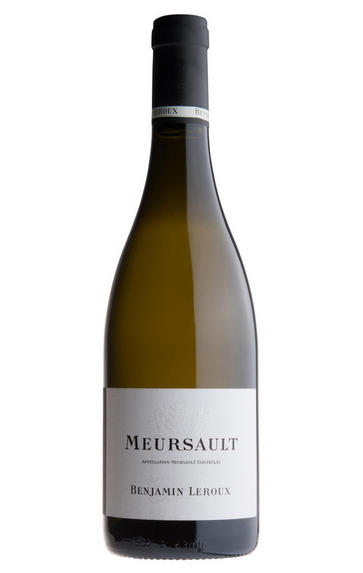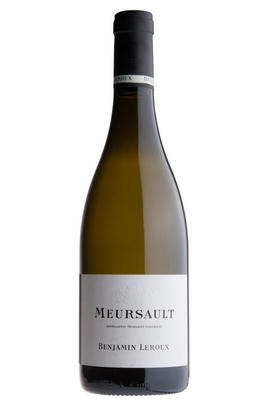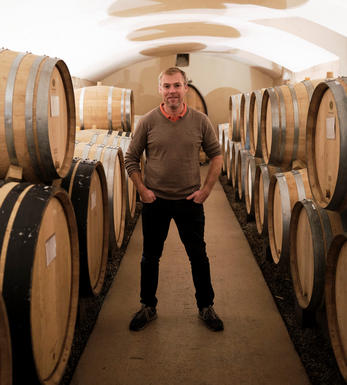
2018 Meursault, Benjamin Leroux, Burgundy

Critics reviews
Lower slopes, eg Les Criots, Au Moulin Landin, Les Millerands, Au Village (all mainly clay) and some from Le Bois de Blagny (calcareous) to add tension. 100% domaine vines. A big cuvée – 12,000 bottles. Fermented and aged in a 12-hl foudre plus 600- and 300- and 228-litre barrels.
Deep, creamy spicy nose. There’s a generosity here and quite a bit of oak sweetness. An easy drinker with just enough acidity for shape. Lots of spice on the creamy finish. Gentle and generous but harmonious.Drink 2020 - 2024
Julia Harding MW, jancisrobinson.com (Nov 2019)
About this WINE

Benjamin Leroux
Having created a name for himself as régisseur (general manager) of Domaine du Comte Armand in Pommard, Benjamin Leroux established, with English backing, a small négociant business based in Beaune since 2007. The range is confined to the Côte d’Or, from Chassagne-Montrachet to Gevrey-Chambertin, with the intention of developing farming contracts or indeed purchasing vineyards in the future.
The possibilities are very exciting for this exceptionally talented vigneron. Benjamin is a master at delivering purity of fruit alongside a seamless texture in his wines which have only the subtlest influence of oak. One of Benjamin’s favourite locations for white wine vineyards is the border between Auxey-Duresses and Meursault, which is where Les Vireuils can be found. Here the natural weight of Meursault is enhanced by the fresher minerality typical of the side valley of Auxey-Duresses.
Jasper Morris MW, Burgundy Wine Director and author of the award-winning Inside Burgundy comprehensive handbook.
Discover the story behind our Own Selection Bourgogne Côte d’Or Pinot Noir, made for us by Benjamin. Read more

Meursault
There are more top producers in Meursault than in any other commune of the Côte d’Or. Certainly it is the most famous and popular of the great white appellations. Its wines are typically rich and savoury with nutty, honeyed hints and buttery, vanilla spice from the oak.
Even though it is considerably larger than its southerly neighbours Chassagne and Puligny, Meursault contains no Grands Crus. Its three best Premiers Crus, however – Les Perrières, Les Genevrières and Les Charmes – produce some of the region’s greatest whites: they are full, round and powerful, and age very well. Les Perrières in particular can produce wines of Grand Cru quality, a fact that is often reflected in its price. Meursault has also been one of the driving forces of biodynamic viticulture in the region, as pioneered by Lafon and Leflaive.Many of the vineyards below Premier Cru, known as ‘village’ wines, are also well worth looking at. The growers vinify their different vineyard holdings separately, which rarely happens in Puligny or Chassagne. Such wines can be labelled with the ‘lieu-dit’ vineyard alongside (although in smaller type to) the Meursault name.
Premier Cru Meursault should be enjoyed from five to 15 years of age, although top examples can last even longer. Village wines, meanwhile, are normally at their best from three to 10 years.
Very occasionally, red Meursault is produced with some fine, firm results. The best red Pinot Noir terroir, Les Santenots, is afforded the courtesy title of Volnay Santenots, even though it is actually in Meursault.
- 305 hectares of village Meursault. The best vineyards include Clos de la Barre, Tesson, Chevalières, Rougeot, Narvaux
- 132 hectares of Premier Cru vineyards (17 in all). The finest vineyards include Les Perrières, Les Genevrières and Les Charmes
- Recommended producers: Comte Lafon, Arnaud Ente, Coche Dury, Guy Roulot, Jean-Philippe Fichet, Patrick Javillier, François Jobard, Michel Bouzereau
- Recommended restaurant: Le Chevreuil

Chardonnay
Chardonnay is often seen as the king of white wine grapes and one of the most widely planted in the world It is suited to a wide variety of soils, though it excels in soils with a high limestone content as found in Champagne, Chablis, and the Côte D`Or.
Burgundy is Chardonnay's spiritual home and the best White Burgundies are dry, rich, honeyed wines with marvellous poise, elegance and balance. They are unquestionably the finest dry white wines in the world. Chardonnay plays a crucial role in the Champagne blend, providing structure and finesse, and is the sole grape in Blanc de Blancs.
It is quantitatively important in California and Australia, is widely planted in Chile and South Africa, and is the second most widely planted grape in New Zealand. In warm climates Chardonnay has a tendency to develop very high sugar levels during the final stages of ripening and this can occur at the expense of acidity. Late picking is a common problem and can result in blowsy and flabby wines that lack structure and definition.
Recently in the New World, we have seen a move towards more elegant, better- balanced and less oak-driven Chardonnays, and this is to be welcomed.


Buying options
Add to wishlist
Description
This cuvée is now made entirely from domaine vineyards scattered around the appellation, including Criots, Sous la Velle, Millerands, Moulin Landin and Bois de Blagny. A perfect combination of rich fruit, power and saline minerals, this is classic Meursault but with Ben’s hallmark purity and freshness. Drink 2021-2026.
"If you haven’t discovered Benjamin Leroux’s wines yet, I wholeheartedly recommend starting with this one. It has delicious notes of ripe stone-fruit, rich vanilla and toast, with refreshing acidity; it bursts with passionfruit, pear, mineral and vanilla. Unusually for the region, this is bottled with a screwcap; the wine retains a freshness that balances out the lush fruit and oak. This is a perfect wine to enjoy in the summer: it’s fantastic with whole roast salmon, or simply on its own, with a good book in the sun."
Henrietta Gullifer, Wine & Spirits Advisor, Berry Bros. & Rudd (June 2021)
wine at a glance
Delivery and quality guarantee